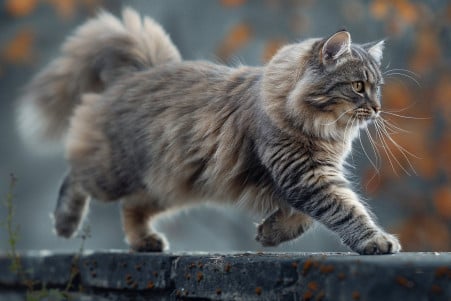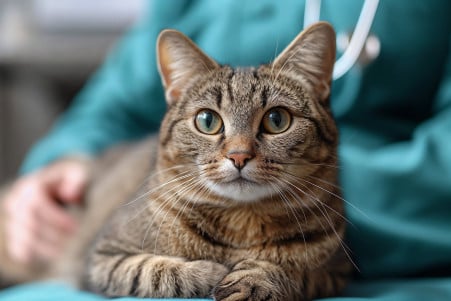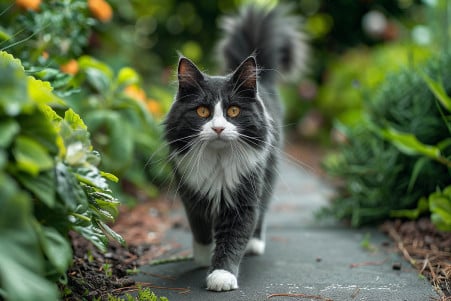Why Do Cats Have Tails? Unraveling the Feline Tail Mystery
19 February 2024 • Updated 19 February 2024

A cat’s tail is much more than an appendage to its spine, but what exactly is it for? Cats use their tails for balance, especially when they are climbing or making other acrobatic moves. They also use their tails to communicate, and the positions and movements of their tails can signal emotions like fear and happiness. The tail’s anatomy, which includes muscles, nerves, and vertebrae, enables these uses.
Throughout this article, we will investigate the intriguing meeting points of veterinary medicine, animal behavior science, and evolutionary biology to reveal the nuances of feline anatomy and behavior.
You will discover the scientific basis for the physical and functional properties of cat tails, find out how different cat breeds demonstrate a range of tail characteristics, and understand the behavioral meaning of tail positions. This in-depth examination will deepen your knowledge of these mysterious animals and the unspoken messages of their tails.
Why do cats have tails?
Anatomy and Purpose of the Cat Tail
According to Catster, the cat’s tail is a wonder of feline anatomy, accounting for about 10% of the cat’s total number of bones. The tail is made up of approximately 20 caudal vertebrae that decrease in size from the base to the tip, which allows for the cat to move it with grace and precision. The tail is also flexible due to the presence of soft discs between each vertebra.
The tail’s muscles, including the caudofemoralis, are important for both the cat’s movement and communication, and they are connected to the skeleton by tendons so the cat can move the tail up and down.
A study posted to PubMed notes that specific muscles are responsible for the cat’s ability to bend and curl its tail. The tail’s nerves are responsible for its sensitivity and its role in nonverbal communication, which is important to cats’ social lives.
That said, the tail’s complexity also means that it can be easily injured. According to Fussie Cat, tail injuries can lead to permanent damage and loss of control over basic functions. However, cats can also adapt to the loss of their tails, as seen in cats with naturally short or no tails like the Manx.
So, an understanding of the tail’s anatomy shows that it is important for both balance and communication, which makes it easier to appreciate these nimble, expressive animals.
Walking the Line: The Cat’s Tail as a Balancing Act
Cats are known for their grace, a trait that comes from their evolution, and the tail is an important part of their ability to maintain balance during their most daring acrobatics.
According to a report by A-Z Animals, cats use their tails to counteract changes in their center of gravity when they are walking along narrow ledges like fences or shelves, helping them to stay upright. This is especially important when they are leaping or running after prey, as it allows them to change direction quickly while still maintaining their balance.
Rover.com notes that the average 12-inch length and flexibility of the tail make it a perfect tool for this job, and the tail’s complex system of vertebrae and muscles make it possible for cats to make both subtle and dramatic movements.
However, tailless breeds, such as the Manx, have evolved to learn how to balance without a tail, showing just how adaptable cats can be.
This is demonstrated in real life, including in a video from the BBC, which shows how the snow leopard’s tail helps it navigate the rough terrain it calls home, proving that the tail is an important part of a cat’s ability to move with agility.
While we marvel at the physical feats of these animals, it’s the tail’s role in everyday cat behavior that we find most fascinating.
Understanding Cat Body Language: The Tail
Cats use their tails to convey a wide range of emotions and messages, which can give us a window into their social lives. For example, the tail held high is a sign of confidence and a friendly greeting, and is often seen when cats greet people or other cats, according to a study in the journal PMC.
On the other hand, a low or tucked tail can signal fear or submission. Even the way a cat moves its tail can be a sign of how it’s feeling, with a slow swish indicating irritation and a fast swish indicating excitement.
The way cats position their tails in relation to other cats can also tell us a lot about their social lives. A study by Simona Cafazzo found that cats in a group who are lower in the social hierarchy will often hold their tails up in a sign of submission and friendliness to higher-ranking cats.
In this way, the ‘tail up’ position is a sign of emotion and is important in the maintenance of social hierarchies.
Even involuntary tail movements, like the tip of the tail twitching, can indicate that a cat is focused or slightly agitated, and are therefore important in understanding cat behavior. These movements are also important in understanding cat communication, as they can help us understand the way cats behave in groups. In learning to understand these movements, we can come to understand the evolutionary adaptations that have made cats such effective communicators.
Evolutionary Perspectives on the Cat’s Tail
Looking at the evolutionary history of the domestic cat, the tail has played a critical role in balance, communication, and survival. An article in Scientific Reports explains that vertebrate tails, including those of cats, have evolved in a variety of ways, suggesting multiple independent events of shortening or complete loss in different lineages.
Cats, with their wide range of tail lengths and shapes, are an example of these evolutionary changes, and certain genetic mutations have been linked to these traits.
The article also points out that some Asian domestic cats have short tails due to mutations in the HES7 gene. This mutation results in a range of tail shapes, from minor kinks to the extreme truncation seen in breeds like the Japanese Bobtail. This kind of genetic variation is a prime example of how adaptable and ever-changing the domestic cat has been.
This knowledge of genetic factors can help us better understand how selective breeding and domestication have shaped the development of today’s pet cats. It also underscores the importance of the tail in a cat’s physical and social abilities, both in the past and in the present day. This insight into feline genetics deepens our understanding of the way cats have thrived in human company, further enriching the intricate fabric of their relationship with people.
After the Injury: How Tail Damage Affects Cats
Tail injuries can have a major impact on a cat’s life, affecting their ability to balance, move, and even their personality. According to PetMD, common tail injuries include bite wounds, which can lead to serious infections, and fractures or dislocations, which are typically the result of trauma.
Tail pull injury, a common neurological disorder in cats, can lead to a loss of tail movement and bladder control, and requires immediate attention, as noted by NDSR.
Veterinarians can help by prescribing a variety of treatments, from antibiotics for bite wounds and skin infections to amputation for more severe cases like degloving injuries or when nerve damage is present. Cats are also known to be resilient after these injuries, and they will often adjust their behavior to help them maintain their balance and mobility.
VCA Animal Hospitals point out that while some tail injuries can be treated at home with some basic first aid, it’s important to know when your cat is in distress and needs to be seen by a vet.
Pet parents can help prevent tail injuries by keeping their cats indoors and making sure their home is free of sharp objects and other things that could lead to entrapment. As this article has shown, the tail is a very important part of a cat’s anatomy, and it’s also a good reminder of the importance of being a vigilant pet parent and taking steps to prevent injuries to our feline friends.
Thinking About the Classic Cat Tail
In conclusion, as we have delved into the rich and complex world of cats and their tails, it’s impossible not to be amazed by the many ways in which this appendage helps cats maintain balance, move with agility, and communicate with nuance.
The tail’s complex anatomy, complete with vertebrae, muscles, and nerves, allows cats to carry out everything from high-risk jumps to the most nuanced emotional expressions, as indicated by The Dodo and Rover.com.
The cat’s tail has evolved from a tool that helped ensure the species’ survival to an emotional barometer, and that’s a clear indication of the power of nature. After all, as the example of the Manx shows, even if they lack a tail, cats can adapt and thrive, moving through life with grace.
However, as a Cats.com article shows, we also need to think about the impact of tail injuries, which remind us of the importance of the cat tail in both the cat’s body and their daily life and activities, and the importance of protecting it.
In the end, the cat tail is more than a physical feature, it’s a key part of a cat’s identity and abilities. So as we conclude this exploration, let’s do so with a greater understanding and deeper respect for these amazing animals and the silent, swishing harmony of their tails.


